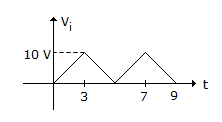Electronics and Communication Engineering - Electronic Devices and Circuits
Exercise : Electronic Devices and Circuits - Section 3
- Electronic Devices and Circuits - Section 14
- Electronic Devices and Circuits - Section 27
- Electronic Devices and Circuits - Section 26
- Electronic Devices and Circuits - Section 25
- Electronic Devices and Circuits - Section 24
- Electronic Devices and Circuits - Section 23
- Electronic Devices and Circuits - Section 22
- Electronic Devices and Circuits - Section 21
- Electronic Devices and Circuits - Section 20
- Electronic Devices and Circuits - Section 19
- Electronic Devices and Circuits - Section 18
- Electronic Devices and Circuits - Section 17
- Electronic Devices and Circuits - Section 16
- Electronic Devices and Circuits - Section 15
- Electronic Devices and Circuits - Section 1
- Electronic Devices and Circuits - Section 13
- Electronic Devices and Circuits - Section 12
- Electronic Devices and Circuits - Section 11
- Electronic Devices and Circuits - Section 10
- Electronic Devices and Circuits - Section 9
- Electronic Devices and Circuits - Section 8
- Electronic Devices and Circuits - Section 7
- Electronic Devices and Circuits - Section 6
- Electronic Devices and Circuits - Section 5
- Electronic Devices and Circuits - Section 4
- Electronic Devices and Circuits - Section 3
- Electronic Devices and Circuits - Section 2
36.
An RC driving point impedance function has zeros at s = - 2 and s = - 5. The admissible poles are
Answer: Option
Explanation:
In RC functions poles and zeros are interlaced.
37.
A triangular Pulse of 10 V peak is applied to a capacitor of 0.4 F. The change of the capacitor and its waveform is


Answer: Option
Explanation:
q = cv  0.4 x 10
0.4 x 10  4, triangular pulse.
4, triangular pulse.
38.
A 10 μF capacitor is charged from a 5 volt source through a resistance of 10 kΩ. The charging current offer 35 m sec. If the initial voltage on C is - 3 V is
Answer: Option
Explanation:
Initial current immediately after charging = 
i = i0e-t/RC  0.8 mA x
0.8 mA x 
 0.8 x 10-3
0.8 x 10-3  0.56 mA.
0.56 mA.
39.
If an admittance Y(s) has a term Ks, the realization would give
Answer: Option
Explanation:
Admittance of a capacitance K is Ks.
40.
If the diameter of a wire is doubled, the current carrying capacity of the wire becomes
Answer: Option
Explanation:
Since diameter is doubled, area of cross-section becomes four times. Current carrying capacity is proportional to area of cross-section.
Quick links
Quantitative Aptitude
Verbal (English)
Reasoning
Programming
Interview
Placement Papers